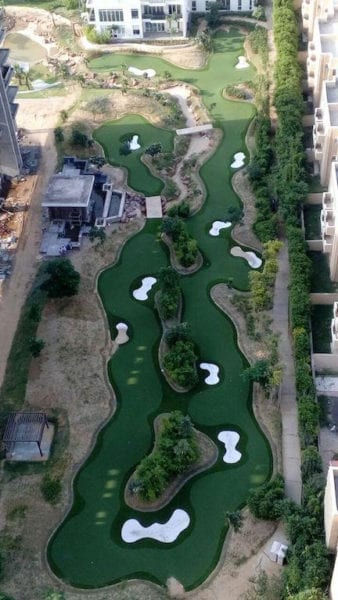At the end of 2015, Rand Jerris, Ph.D. the Senior Managing Director of Public Services for the United States Golf Association gave an interview to my guest writer Rich O’Brien about sustainability. Rand Jerris said in that interview that “With these challenges in mind, for the golf course industry to be sustainable, it will be important to reduce maintenance costs and manage water consumption.”
This is why I thought to investigate Golfplan‘s new project, the M3M Club in India. When it opens this September, M3M will not only be India’s newest golf property; it will also be the first anywhere to deploy synthetic turf through the green. The 9-hole, par-3 layout at M3M Club — in addition to its 9-hole putting course and driving range — are entirely “grassed” with a lush-green product produced by FieldTurf (golf is not highlighted on their website unlike football, soccer, baseball, softball, lacrosse, rugby, field hockey etc.).

Golfplan partner Kevin Ramsey explained his choice by “the shade created by these high-rises (two 35-storey towers) would have made it quite difficult to grow and maintain healthy turf here, no matter what varietal was chosen. But mainly, it’s for the residents. This FieldTurf will always look good. There will be no dormancy, no off-color in the off-season.”
He also said, “You’d have a very difficult time maintaining year-round turf in this climate (in the dry season in India the temperature can even reach 48 degrees/118 degrees Fahrenheit), with all this shade, to say nothing of the water that it would require. Asians, in particular, appreciate the garden aspect of golf, as opposed to the brown, naturally rough-hewn golf most prized in the West.”

Although I agree with the points and claims of Kevin Ramsey about the benefits of synthetic turf, I strongly recommend considering the following aspects before you would run ask for a proposal for a golf course built of synthetic turf:
- Try to assess the replacement costs.
- Operational costs: irrigation, grooming and drag/power brushing; moss and algae prevention and removal, etc. Turf life of FieldTurf is 8-10 years.
- Bear in mind initial capital costs, e.g. design; project management costs; site assessment, base construction, drainage and other civil engineering considerations; engineering services, maintenance machinery (+future amortization costs!!) etc.
- Lifecycle costs (FieldTurf is promising that their drainage bases can have a lifespan of 20-30 years).
The study of Government of Western Australia (published in 2011) found that across all of the sports synthetic turf over a 25 year and 50-year lifecycle synthetic turf had a higher lifecycle cost than natural grass.
I would ask Golfplan and FieldTurf:
- How will the golf course manage the monsoon rain showers? Will it cause extra costs for the M3M Golf Estate?
- What can golfers do during the monsoon rains? Will they loose the period of July – November, just because of the monsoon?
- Heat hazard: how people will be able to play in the extremely hot Indian weather? On a 98-degree day, the temperature of the turf could rise to more than 120 degrees.
- Is there any danger of lead, zinc hazard, toxic metals, toxic run-off (can endanger drinking water), bacterial breeding etc.?
- How can you give back the emotional value of a natural turf if the garden aspect is so important?
